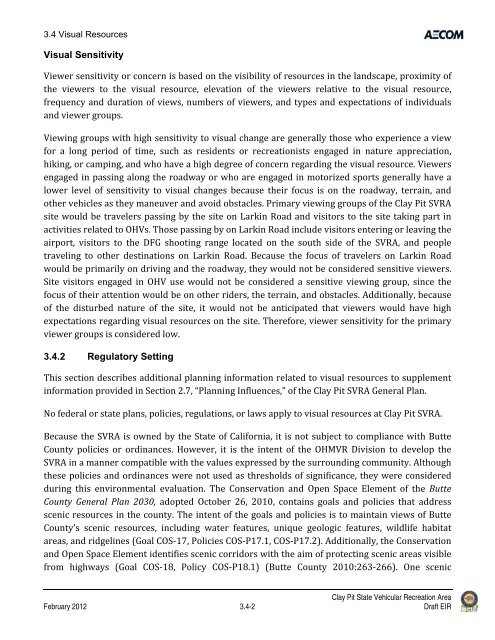Draft Environmental Impact Report - California Off Highway Vehicle ...
Draft Environmental Impact Report - California Off Highway Vehicle ...
Draft Environmental Impact Report - California Off Highway Vehicle ...
Create successful ePaper yourself
Turn your PDF publications into a flip-book with our unique Google optimized e-Paper software.
3.4 Visual Resources<br />
Visual Sensitivity<br />
Viewer sensitivity or concern is based on the visibility of resources in the landscape, proximity of<br />
the viewers to the visual resource, elevation of the viewers relative to the visual resource,<br />
frequency and duration of views, numbers of viewers, and types and expectations of individuals<br />
and viewer groups.<br />
Viewing groups with high sensitivity to visual change are generally those who experience a view<br />
for a long period of time, such as residents or recreationists engaged in nature appreciation,<br />
hiking, or camping, and who have a high degree of concern regarding the visual resource. Viewers<br />
engaged in passing along the roadway or who are engaged in motorized sports generally have a<br />
lower level of sensitivity to visual changes because their focus is on the roadway, terrain, and<br />
other vehicles as they maneuver and avoid obstacles. Primary viewing groups of the Clay Pit SVRA<br />
site would be travelers passing by the site on Larkin Road and visitors to the site taking part in<br />
activities related to OHVs. Those passing by on Larkin Road include visitors entering or leaving the<br />
airport, visitors to the DFG shooting range located on the south side of the SVRA, and people<br />
traveling to other destinations on Larkin Road. Because the focus of travelers on Larkin Road<br />
would be primarily on driving and the roadway, they would not be considered sensitive viewers.<br />
Site visitors engaged in OHV use would not be considered a sensitive viewing group, since the<br />
focus of their attention would be on other riders, the terrain, and obstacles. Additionally, because<br />
of the disturbed nature of the site, it would not be anticipated that viewers would have high<br />
expectations regarding visual resources on the site. Therefore, viewer sensitivity for the primary<br />
viewer groups is considered low.<br />
3.4.2 Regulatory Setting<br />
This section describes additional planning information related to visual resources to supplement<br />
information provided in Section 2.7, “Planning Influences,” of the Clay Pit SVRA General Plan.<br />
No federal or state plans, policies, regulations, or laws apply to visual resources at Clay Pit SVRA.<br />
Because the SVRA is owned by the State of <strong>California</strong>, it is not subject to compliance with Butte<br />
County policies or ordinances. However, it is the intent of the OHMVR Division to develop the<br />
SVRA in a manner compatible with the values expressed by the surrounding community. Although<br />
these policies and ordinances were not used as thresholds of significance, they were considered<br />
during this environmental evaluation. The Conservation and Open Space Element of the Butte<br />
County General Plan 2030, adopted October 26, 2010, contains goals and policies that address<br />
scenic resources in the county. The intent of the goals and policies is to maintain views of Butte<br />
County’s scenic resources, including water features, unique geologic features, wildlife habitat<br />
areas, and ridgelines (Goal COS‐17, Policies COS‐P17.1, COS‐P17.2). Additionally, the Conservation<br />
and Open Space Element identifies scenic corridors with the aim of protecting scenic areas visible<br />
from highways (Goal COS‐18, Policy COS‐P18.1) (Butte County 2010:263‐266). One scenic<br />
Clay Pit State Vehicular Recreation Area<br />
February 2012 3.4-2 <strong>Draft</strong> EIR








